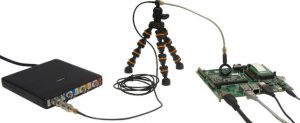
Called Handyscope HS6 DIFF-1000XMESG, the supplied TP-EMI-HS6 probe set contains three magnetic field (H field) probes and one electric field (E field) probe, plus a tripod to position the probes in the correct position relative to the object under test.
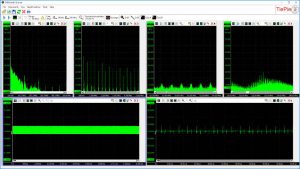 Total 0-500MHz spectrum, three magnified views of it, total time domain signal and one magnified view of that.
Total 0-500MHz spectrum, three magnified views of it, total time domain signal and one magnified view of that.
The EMI analyser software has a multi window option where the the total spectrum or a selected part of the spectrum is simultaneously shown in each window. “This gives the user a better understanding of the signals that are analysed,” said the firm. “Besides the spectrum, also a time domain signal is visible, allowing to analyse the signal shape at the same time. The multi display option is also available for the time domain signal.”
It has a resolution bandwidth of up to 7.45Hz at 500MHz span allowing a lot of detail to be extracted – a total of 67,108,864 spectral components. “When your display is 1,920 pixels wide, you require 34,952 displays to show the full spectrum 1:1,” said TiePie, “34,952 displays with a width of 50cm each gives a total display width of 17.47km – so, if you zoom in 35,000 times, you will get the spectral components 1:1 on your display. That is exceptional for an EMI analyser.”
Dynamic range is 140dB, and standard limit lines according to EN61326-1:2006 / EN55011:2007 can be switched on or off. The resolution bandwidth and frequency range can be selected individually.
There are three operating modes:
- Normal mode displays the spectrum of the source trace.
- Averaging mode is effective in reducing the noise of the signal, to see more of the harmonic or carrier detail. You can select the number of spectra to be averaged.
- Max Hold displays the maximum level that the signal reaches and is useful for frequency measurements where it shows the history of peak values across the frequency axis.
Averaging and Max Hold history can be cleared manually to start a new measurement.
Amplitude unit can dB, dBv, dBmV, dBµV, dBµV (at 10m) and dBm.
Amplitude range can be set to : 1-100dBµV, 20-120dBµV or 40-140dBµV. “For accurate amplitude measurement, a flat top window is used by default. Besides the flat top window, eight other windows can be selected from,” said the firm.
The set-up can also be used as normal spectrum analyser, and with a biconical antenna or combilog antenna (neither in kit), a spectrum of 10 to 500MHz can be measured.
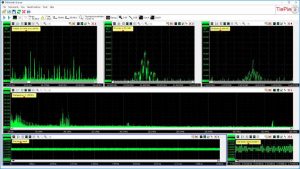 Spectrum measured with a Combilog antenna. Next to the full 0-500MHz spectrum, there is the 87.5-108MHz FM band with a station at 92.2MHz, an AM station at 1,600kHz, the time domain signal, and a zoomed part of the time domain signa
Spectrum measured with a Combilog antenna. Next to the full 0-500MHz spectrum, there is the 87.5-108MHz FM band with a station at 92.2MHz, an AM station at 1,600kHz, the time domain signal, and a zoomed part of the time domain signa
The Handyscope HS6 DIFF-1000XMESG EMI analyser consists of a Handyscope HS6 DIFF-1000 with option E installed.
Option E also includes the EMI probe set TP-EMI-HS6 in a carrying case – three differently sized H field probes and an E field probe. A short semi flexible antenna cable and a long flexible antenna cable are included, as is a grounded 50Ω terminator.
 Electronics Weekly Electronics Design & Components Tech News
Electronics Weekly Electronics Design & Components Tech News
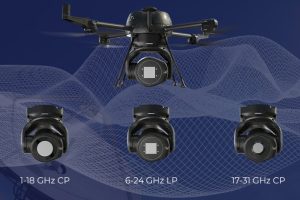

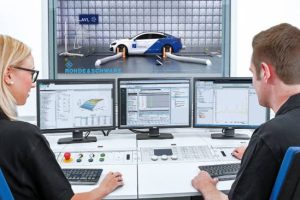
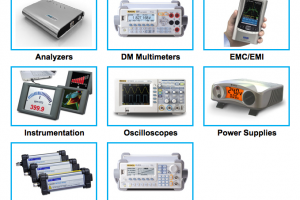
Hi Steve.
Picoscope is another great USB scope company. From a marketing point of view (I guess wildly) it is such a shame that USB scopes, although they are often high performance, don’t look as nice as a scope with knobs and a screen.
On the EMC front, you are the guy to listen to!
regarding Picoscope and knobs… I was listening to an interview with a fellow from HP/Agilent/Keysight, and the subject of knobs came up. Don’t recall the details, but there was a comment about having learned the lesson and adding knobs back to the front panel.
I recall using a very early HP digital scope and being frustrated by the nested menus and lack of knobs. Not sure if I’d be happy with a PC based scope, based on that experience. Perhaps it depends on how crowded the lab bench is??
Nice to hear from you Steve
I remember the early ‘few-knob’ digital scopes – how frustrating to use.
Having used PC scopes, they are not as bad as that, but not as nice as a scope with knobs.
I have experience with a model from PicoScope (darn good products) and the controls allowed by the huge screen area + mouse + keyboard take away some of the frustration. Actually. the huge screen area is brilliant!
I have even used one outdoors, on a long power lead.
One odd thing, I am so used to ‘rich’ on-screen experiences that, despite being functionally excellent, the PicoScope software version I used looks a little bland in comparison to more usual PC software – revealing that am as much a fashion victim as many other folk.
Interesting device! I’m amazed at how much scopes have improved in regards to their ability to do a really quick FFT and function as a spectrum analyzer.
I like the idea of E and H probes as a means to look for sources of noise, but I’ve wondered how useful they really are as a pre-compliance tool. So many EMC problems are due to problems with the cables attached to the device that it’s hard to use these probes to sniff around the board and identify which signals will cause emissions problems. The probes might be more useful after doing an initial emissions test, as a way to find which board traces are carrying the frequencies where the device is failing the test.